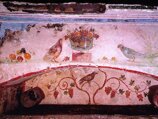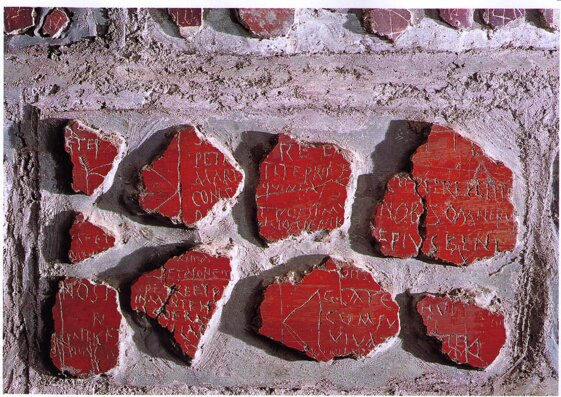
© Catacombe San Sebastiano 2026
Via Appia Antica 134 Roma 00179 Italia

IL CIMITERO SOTTERRANEO
Il sito era originariamente chiamato 'ad catacumbas' o, secondo la spiegazione più comune, 'vicino alla cava', a causa della presenza di antiche cave di pozzolana. Attraverso l'uso abituale, questo toponimo fu poi utilizzato per indicare i cimiteri cristiani sotterranei, oggi noti come catacombe. Come spesso accadeva nell'antichità, la cava fu adattata dai cristiani a cimitero, con modesti luoghi di sepoltura come loculi e arcosoli.
La comunità cristiana, dato il gran numero dei suoi membri, il processo di inumazione e l'alto costo dei terreni suburbani, continuò a scavare la cava di tufo per formare una rete di 12 km di gallerie sotterranee divise su tre livelli. Prima dell'avvento del cristianesimo i Romani chiamavano i loro luoghi di sepoltura "nekropolis", parola greca che significa città dei morti.
I primi cristiani, invece, preferivano chiamare i loro luoghi di sepoltura 'cimitero', dal greco 'koimào' che significa 'dormire'. Lungo le gallerie sotterranee noterete la grande varietà di tombe e decorazioni. Ogni tomba aveva un suo piccolo segno per essere riconosciuta, come un oggetto o un semplice frammento di una lampada, una moneta, un fondo di coppa, gioielli o un giocattolo di un bambino.
In molti casi, un nome graffiato sulla malta di chiusura ci ha tramandato la memoria del defunto. La sepoltura del martire Sebastiano fu un evento fondamentale per lo sviluppo e la notorietà della catacomba, e la venerazione di questo testimone di Dio provocò profondi cambiamenti all'interno della catacomba. Grazie alla sua presenza, i luoghi vicini alla sua venerata tomba erano sempre più ricercati.
LA MEMORIA APOSTOLORUM
Verso la metà del III secolo d.C., la topografia del luogo fu letteralmente sconvolta. La 'Piazzuola' fu completamente colmata e sopra i mausolei venne creato un cortile. In quel periodo fu creata la 'triclia', un ambiente coperto accessibile tramite una piccola scala, e costituito da una grande sala porticata circondata da una panca su tre pareti.
Molti studiosi ritengono che, proprio in questo periodo, questo complesso abbia temporaneamente ospitato le spoglie degli apostoli e martiri Pietro e Paolo. Inoltre, venne chiamato 'Memoria Apostolorum', e sulla parete di fondo furono trovati molti graffiti con invocazioni e preghiere rivolte a Pietro e Paolo, testimonianze della profonda venerazione dei due santi.
Alcuni di questi interessanti e suggestivi graffiti sono ancora visibili, come quello di un certo pellegrino che scrisse: 'Paule et Petre petite pro Victore', richiesta di intercessione rivolta ai due martiri più importanti del Cristianesimo.
